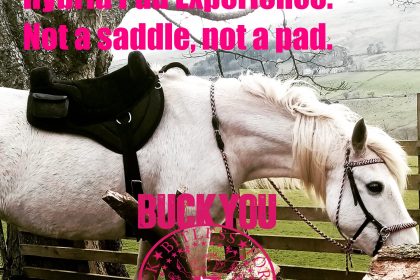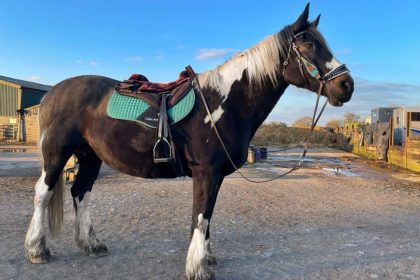Well, maybe not that dramatic…
This blog is bought to you by a desperate search to find a way to beat the Dunning-Kruger effect WITHOUT getting into really frustrating arguments.
I have a slight reputation for being feisty. Total nonense, I am as sweet, fluffy and gentle as they come. I will cut you in the blink of an eye if you mess with one of my beasts though. You only get one chance…
Anyway. Despite my reputation, I do actually try really hard to discuss new and alternative horse science with people without swearing at them, stabbing them or going off to feed the cats (that’s a long story which eventually involved threats made to my personal safety!).
I try many methods, I appeal to common sense I use metaphor, I ask them to put themselves in their horses shoes (or lack thereof in better cases). I will even put myself in their shoes- after all, I used to use a whip, I used to think bits were fine, I used to think I had to be in charge at all times…
The thing is though, I’ve learned, and instead of accepting what I’d been told or read in the usual pony care books as verboten, I started to look at the WHY behind the how.
Yes, you can control a horse with a bit, but WHY does that work?
Yes, a horse behaves differently and in a way which is much more pleasing to the rider when a whip is carried- even if it’s not used, but WHY does it’s behaviour change?
Then when I started to understand why these things did what they did, I started to think about the emotional impact this has on the horse. I started to realise my ‘friendships’ were insanely one sided dictatorships in which I hold absolute power over Every Single Aspect of the horses life.
That was indeed a bitter pill to swallow and a long, hard look at everything I’d ever done with or more correctly, TO a horse followed. It was PAINFUL. It still can be.
The point I am making is, I stopped presuming I knew everything because of Cato. I knew I COULD control him and make him do as I pleased if I was willing to whip him and use bits. But I couldn’t do that to him. If he’d been a quiet horse who just accepted his lot in life, chances are I would have remained blissfully unaware and congratulated myself on being such a gentle and caring person for being bitless and barefoot and not using a whip on my horses or even carrying one.
Cato forced me to look beyond the surface and face the hard truths and pick my path. It sure as hell hasn’t been easy, but my goddess- it has been rewarding (pun intended).
The methods we use to train or work with our horses often result in behaviours that look the same on first glance- a horse picking up his feet for example, but look a bit closer, is there tension around the eyes? Does the horse have freedom to move away? Are they allowed to put their feet down? Are the feet being freely offered or pulled up? Such a simple part of horse keeping, but there are a myriad of ways this can be done with the same end result, but with significantly different emotional impact on the horse.
I continue to learn, and I urge people to look harder at what you THINK you know, don;t just accept what you see ta face value, think about how that amazing behaviour was trained, ponder on how the horse might feel about it. How can they feel happy about it?
Don’t sniff at the people who have the ‘easy’ horses; again, look harder, was that horse always easy to handle or is that the result of a lot of hard work, study and tears?
So, returning to my initial question, how do you gently let someone know that actually, there is a lot you don’t know- and I know this because I was once you?
Answers on a postcard please! Or leave a comment.



2 Comments
Jae
October 14, 2019 at 4:07 pmWhen I first got my horse, I wanted the majority of his work to be hunting (I thought the hunt was cruelty free because they followed people, never killing anything) and a little bit of showing. That plan didn’t go well – he had a habit of bolting, and was uncontrollable and dangerous at every outing. I was given a lot of advice from well-meaning equestrians, and (sadly) tried to follow it rather than ‘just giving up’.
Writing this now makes me cringe, but yeah. I tried ‘running him on empty’, using a stronger bit (Pelham, Waterford gag, Tom Thumb etc), different noseband, martingale, even a stronger rider – nothing worked. My horse still bolted, ran through the pain, and came home with a bloody mouth and sweat dripping off his sides.
After a full season with no improvement, I started ignoring pretty much everyone’s advice and went back to basics. Since then, I’ve ‘re-started’ this horse about 3 times – each time progressively with less traditional ‘control’ and more thought. We went from ‘traditional but insane’, to ‘just a snaffle’, to ‘natural horsemanship’, and then did a 180 and finally settled on +R methods.
When people question it, I just show them some videos of him. The first is from 2014, when he bolted past the camera, in various horrible bits of tack, with a rider practically led backwards on him and pink foam specks everywhere. The second is of him bolting again in a show ring, this time in a snaffle, with the rider trying desperately to turn and do a ‘one rein stop’. The third one is of him trotting bridleless through an open field, stopping on a vocal cue and turning round for a treat. The results generally speak for themselves.
Vikki
October 27, 2019 at 10:34 pmWOW! You truly are an ambassador for force free, that’s a brilliant story!